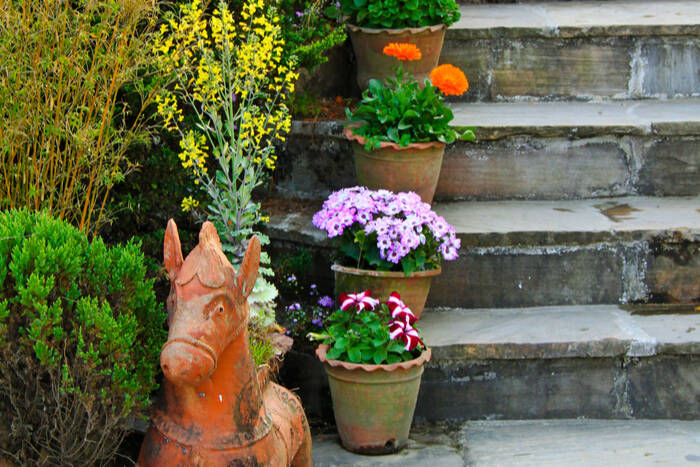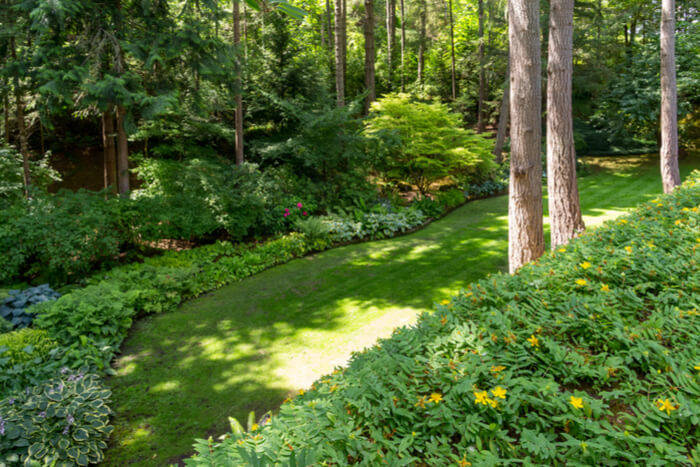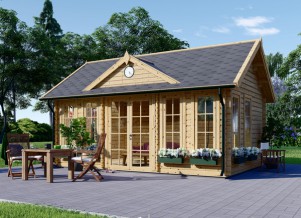Do you love to garden? Have you been avoiding it because your backyard is a slope? If you answered yes to both these questions, we are here to help. Today, we will give you the 16 most important tips and tricks to keep in mind when gardening on a slope.
16 Tips and Tricks for Gardening on a Slope
#1. Add Terraces
A few terraces can add a lot of character as well as a lot of gardening opportunities. On these terraces, you can add quite a few containers or even a whole raised bed. On one of the terraces you should think about putting a wooden shed (check there wooden sheds kits) to make getting to your tools much easier.
The sky, and the space you have available, is the only limit!
#2. Build a Retaining Wall
Retaining walls work very well to separate spaces in a sloping yard. It also allows you the opportunity to plant where you couldn’t plant before. Just remember to build it out of materials that encourage planting. That means anything that has plenty of nooks and crannies!
Some plants that love to grow in crevices are sedums, hens-and chicks, and sweet alyssum. If you build multiple retaining walls and even out the soil on each, you can the whole yard into a garden.
#3. Build Some Stairs
Although it may take some heavy elbow grease, or a professional, the addition of stairs can transform your gardening opportunities. If your slope is steep, add the stairs in like switchbacks using stone. It creates a dramatic effect as well as gives you space to put pots and garden cover.
If you make the stairs extra-wide, you can effectively create a container garden on your staircase!
#4. Go Native
Instead of trying to plant things that don’t belong, plant things that do! On slopes, it is best to work with what nature gives you. Look for things you want to garden that naturally succeed in your hardiness zone. Also think about seed gathering as a cheap and effective way of going native!
#5. Build a Multi-Level Deck
Nothing is quite as beautiful as a multi-layer deck. You can go as far down the hill and as wide as you like. Add a hot tub, raised garden, container garden, or even pool. Creating a deck like this is a truly remarkable way to garden on a slope.
#6. Plant the Slope
If you decide to plant the slope, go ahead and do it! You just need to pick out the right plants. The best thing to put on uneven terrain is ground cover greenery marked easy-care. The roots on these garden favorites root into the soil to protect against erosion.
#7. Live Like You Are on a Mountain
By this, we mean add boulders to your backyard! This is a great way to add some character to an annoying slope. Boulders also give the soil behind them the opportunity to grow plants. Just remember the bottom half of the rock needs to be buried for stabilization.
#8. Create a Trail
If your plans for your yard don’t include any sort of stairs or decking, you will need to create a trail through your garden. Make it easy to walk on, potentially using switchbacks. This is a great addition to yards where you have planted ground cover or native greenery. It also allows you to get around to water your garden.
#9. Remember Microclimates
Depending on your slope’s elevation change, there may be different microclimates in your yard. If there is, you should monitor the differences in temperature change over time.
#10. Think About Runoff
First, get your yard the way you want it. That includes everything built you plan on building. Now, you need to monitor each area for runoff. Keep an eye out for puddling water so you know where not to plant – or where you can grow water-loving greenery.
#11. Grow Upward, Not Outward
Anywhere you have room for a container you have the opportunity to grow upward with vines. There are plenty of veggies you can plant that grow on trellises. Use stepladders for aesthetics as well as strength to hold up things like pumpkins and gourds.
#12. Be Aware of the Soil Condition
Soil on slopes tends to be drier than flat soil. This is because water doesn’t have the opportunity to soak in before it is carried downhill. Be aware of how much water you are going to use before starting your garden on your hill.
#13. Is it South Facing?
If so, you may have a problem. The southernmost facing slopes receive the most sunlight. That coupled with the bad soil can create difficult growing conditions. These are the perfect conditions for native plants or solely containers and raised beds.
#14. Applying Fertilizer Can Be Hard
The natural downhill trajectory of water applies to fertilizer as well. The plants at the bottom can end up scorched from too much, while the ones at the top end up nutrient hungry. The best way to combat this is, once again, going native.
#15. Consider Erosion When Selecting Flora
There are some steps you can take to combat erosion, and one of those is choosing the right greenery to put in your garden. Try to get the largest plants you can buy. These tend to have the largest root systems. Locate them as close together as the planting instructions allow.
Additionally, landscape mesh and mulch should be used strategically to keep the soil in place.
#16. Remove Weeds Before Planting in the Ground
Our final tip is to remove any and all weeds before you stick anything in the dirt. This will save you time and a harder job down the road. Get in there and dig them out. If you don’t, you will have a more difficult time doing it amid your garden.









